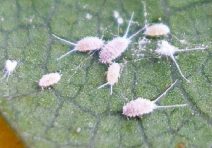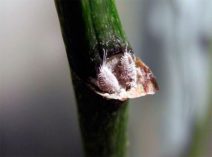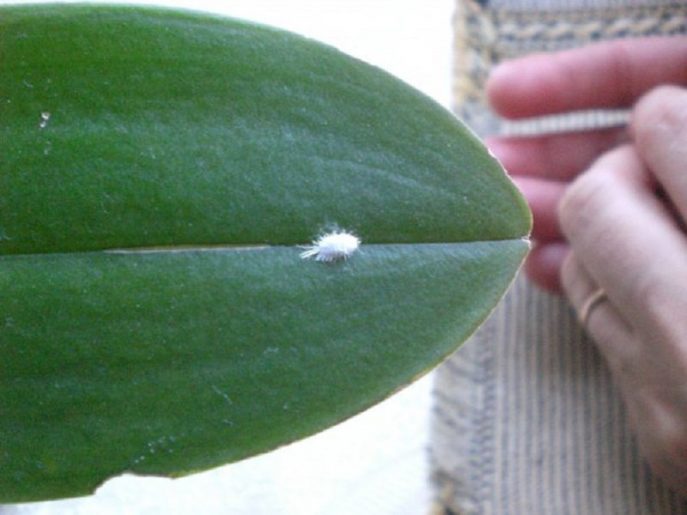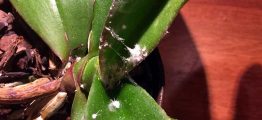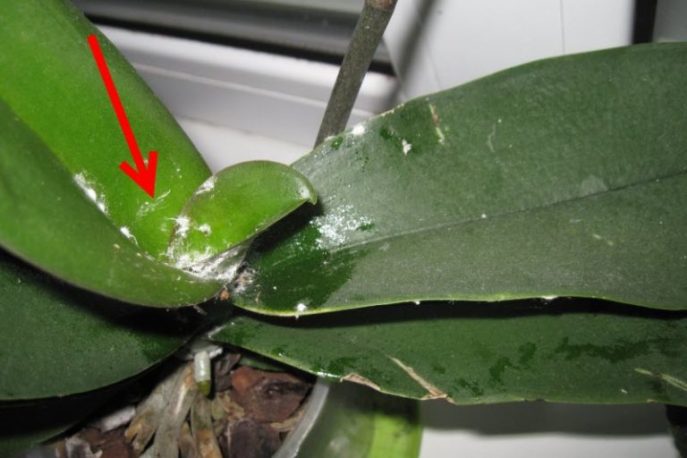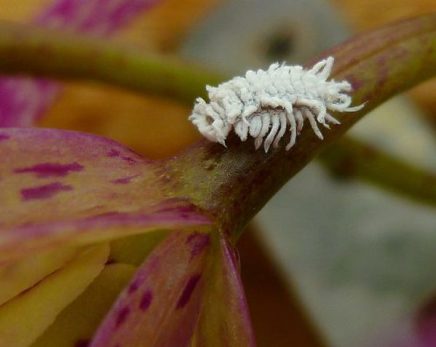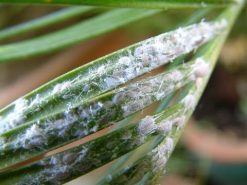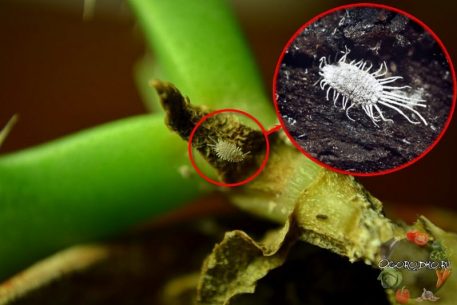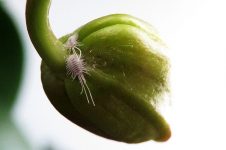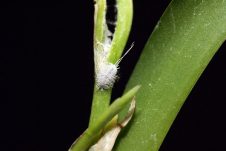Orchids are exotic plants that are very demanding on the conditions of detention. But in addition to the hassle of organizing proper lighting, watering and fertilizing, flower growers have to deal with diseases and pests that often affect this flower. If a mealybug wound on an orchid, how to get rid of it? To save a houseplant, you need to take a number of measures.
Material Content:
Description and types of pest
Mealybugs are small insects that are also called shaggy lice. The species is akin to the scale insect and pseudoscutis.
You can notice this parasite with the naked eye. It has a small, 3 to 6 mm, oval body of white or beige color, along which small setae are located. The insect is very mobile and prolific, and, having hit one plant, it may well move to its “neighbors”.
To date, more than 2,000 varieties of mealybugs are known, the bulk of which prefers to live in a tropical climate. The following populations are considered the most common in European territory:
- Maritime Worms. This parasite reaches sizes from 2 to 5 mm and has a light gray or pink body, covered with wax. The paws of the insect are well developed, which allows it to move quickly. Females of the coastal variety, unlike males, are unable to fly.
- Cactus Worms. These insects have an oval body over 3 mm in length, painted in pink. Females of this species are viviparous, forming a felt bag.
- Bristle Worms. Representatives of this species reach 5 mm in length, and they can be recognized by the orange or pink color of the body, covered with a coating. Such parasites are viviparous and quite prolific, which allows the population to spread rapidly throughout the plant.
- Grape Worms. These insects have a wide body with a length of 3 to 4 mm, having a pink or green color. Parasite setae covered with white bloom, tarsi well developed, their longest being the last pair.
- Citrus Worms. This parasite reaches 3.5 mm in length, and the shade of its body, covered with a coating, ranges from bright yellow to light brown. Sticky bristles are located on the sides of the insect.
- Root Worms. This is a small insect, the length of which ranges from 2 to 3.5 mm. The body of the parasite is elongated, and can be whitish, yellowish or pink. Females lay white oval eggs, protected by cotton-like secretions.
On a note. Male mealybugs of any kind are smaller than females. If the former reach a length of not more than 3 mm, then the body sizes of the latter range from 3.5 to 6 mm.
What is the danger of a mealybug for an orchid?
Mealybug feeds on the sap of plants, which causes them significant damage. The orchid affected by the pest has a painful appearance, intensively loses leaves, and the buds crumble without ever blooming.
In addition, worms in the process of life release a liquid that has a detrimental effect on the plant. In fact, it is a poison that slowly kills potted plants. In addition, "nectar" provokes the multiplication of pathogenic bacteria and fungi, and also attracts other parasite insects.
If you do not remove the mealybug from an orchid or other plant, this will lead to depletion and rapid death of the culture. For this reason, measures should be taken immediately after the first signs of infection have been noticed.
Which varieties are more susceptible to infection?
Any kind of indoor orchid can suffer from a mealybug attack. In addition, the parasite can be found on gerberas, fuchsias, hibiscus, amaryllis, oleander and cacti. Often, as a habitat, he chooses grapes, palm trees or citrus crops.
Read also:gerbera indoor - home care
Infected plants develop worse, shoot growth slows down. The main problem with treating indoor flowers is that worms often lay eggs in places difficult to process.
Causes and symptoms of orchid damage by mealybug
Before starting the question of how to get rid of the mealybug, one should find out for what reasons it appears. The provoking factors include:
- low humidity
- wrong temperature conditions;
- incorrect irrigation and waterlogging of the soil;
- excess nitrogen in the soil as a result of an overdose of fertilizers;
- the presence on the plant of dead parts that were not removed in time.
Note. Often, mealybug eggs are brought into the house by ants, and parasite larvae are easily carried by the wind. For this reason, the windows in the room where the orchids are located must be protected with a fine mesh.
How to understand that worms are parasitic on orchids? It is simply impossible to confuse them with any other pest, and the main sign of the presence of these insects is a whitish coating that resembles cotton balls.
The second symptom is sticky secretions that form on the leaves and stems of the culture, they are called honey dew or pad.
You can save the orchid only if the necessary measures were taken immediately after the detection of alarming symptoms.
How to deal with a mealybug on an orchid?
When the plant is slightly affected by the mealybug, parasites can simply be collected and crushed. But what if the pest colony has grown? In this case, processing with chemicals or formulations prepared from improvised tools will help.
Effective Chemicals
Chemical compounds are most effective in controlling young insects. But since worms of different ages can parasitize on a houseplant, they will have to process the culture several times, repeating these manipulations every 10-14 days.
Among the variety of agents that can help in the fight against parasites, three main groups can be distinguished:
- Contact poisons that enter the body of an insect through the skin. The most common drugs in this group include Spruzit aeschadlingsfrei.
- Intestinal toxins that enter the body of an insect through the mouth. Well-established compositions such as "Actors", "Actellic" and "Nurell-d."
- Systemic compounds that fall into the juice of a plant and make it poisonous. The greatest efficiency can be achieved by using means such as "Phosphamide" or "Rogor".
The components of these drugs are safe for the plant, but harmful to the parasite. When an insect enters the body, substances cause its rapid death.
Treatment with folk remedies
To cure an orchid and get rid of a mealybug, it is not necessary to purchase expensive drugs. You can treat the flower with a solution prepared by yourself.
The most common means to combat colonies of parasites are:
- Olive emulsion. For cooking, you need 200 ml of water and 50 g of olive oil. The components are mixed, and then with the help of a piece of gauze or a disk of cotton wool, the affected areas are treated.
- Soap and alcohol. To prepare such a solution, you will need a liter of boiling water, 20 g of chips from laundry soap and 50 ml of vodka. The components are boiled for several minutes, allowed to cool, and then used for spraying twice a week.
- Garlic. To prepare the product, you need 500 ml of boiling water and several chopped garlic tines. The solution is used to wipe the affected parts of the culture.
Attention! If the listed measures have not yielded results, it is better to destroy the diseased orchid until other indoor plants have been infected.
Pest Prevention at Home
Any problem is easier to prevent than to get rid of it. To protect orchids from the mealybug, you will need to follow a few rules:
- Keep separately from the other plants of the newly acquired "pet" for 10-14 days.
- Properly care for orchids, observing the regime of watering and lighting.
- Regularly fertilize the flower to increase its immunity, since parasites most often affect weakened plants.
- Timely remove dead parts of the culture.
- Periodically arrange for orchids "shower" when heating water from 40 to 50 degrees.
Observing the above rules, there is a chance to minimize the risk of infection of orchids with a mealybug.



